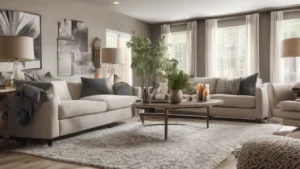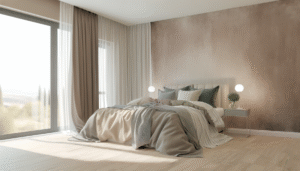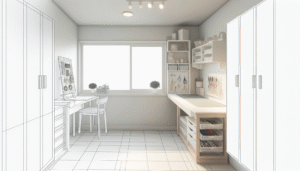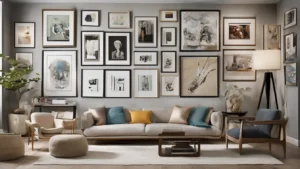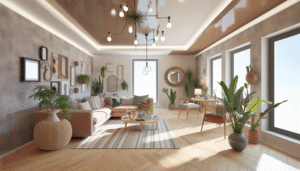
Do you ever feel like your small living space is constantly closing in on you? That no matter how much you declutter or rearrange, it still feels cramped, dark, and utterly overwhelming? You’re not alone. The challenge of maximizing compact areas is a common headache for urban dwellers, apartment residents, and anyone looking to make every square foot count. But what if there was a simple, elegant design choice that could dramatically transform your tiny rooms into havens of light and spaciousness?
Enter the magic of small space solutions using neutral tones. This isn’t just about painting your walls beige; it’s a sophisticated design philosophy that leverages the power of subtle hues to create an illusion of greater square footage, enhance natural light, and foster a sense of calm serenity. Forget restrictive layouts and bulky furniture. Instead, imagine a home that feels open, airy, and effortlessly chic, regardless of its actual dimensions. It sounds appealing, doesn’t it?
In this comprehensive guide, we’ll dive deep into the art and science of utilizing neutral tones to unlock your small space’s full potential. You’ll learn how specific shades can impact perception, discover expert-backed strategies for furniture selection and clever storage, and find actionable tips to infuse personality without sacrificing precious room. By the end, you’ll be equipped with the knowledge to turn your compact dwelling from a cramped corner into a captivating, roomy retreat. Get ready to rethink everything you thought you knew about decorating a small home.
Here’s what we’ll cover:
- The psychological and practical benefits of neutral colors in compact environments.
- Mastering the neutral palette: beyond beige to nuanced whites, greys, and even soft browns.
- Strategic paint choices and how light reflection can work wonders.
- Furniture selection: multifunctional pieces and scaling for small spaces.
- Texture and layering: adding depth without clutter.
- Clever storage solutions that blend seamlessly into your design.
- Integrating natural elements and subtle pops of color.
- Real-world case studies and inspiring transformations.
- Addressing common myths and pitfalls when decorating with neutrals.
- Maintaining your serene aesthetic: cleaning and organization tips.

The Power of Neutrals: Why This Palette Transforms Small Spaces
Why do designers consistently recommend neutral tones for smaller rooms? It’s not just a trend; it’s a fundamental principle of interior design rooted in how humans perceive space and light. Understanding this ‘why’ is crucial for effectively applying these principles in your own home. Neutral colors offer a unique combination of aesthetic and practical benefits that are uniquely suited for compact living, providing a foundation that can truly elevate your environment.
In essence, neutral colors are those without a strong hue, often described as colors that appear without color. Think of your whites, grays, beiges, and even certain soft taupes. These shades are incredibly versatile and serve as a beautiful backdrop for virtually any style. But how do they actively *transform* a small space rather than just making it ‘blend in’?
The Illusion of Expansiveness: How Neutrals Trick the Eye
The most compelling reason to embrace neutrals in a small space is their unparalleled ability to create an illusion of greater size and openness. This isn’t just wishful thinking; it’s a scientifically backed optical effect. Light colors inherently reflect more light than dark colors. When light bounces off light-colored surfaces – walls, ceilings, and even large pieces of furniture – it brightens the entire room.
Consider a small room painted in a deep, saturated color. While visually striking, such a color absorbs light, making the walls appear to advance and shrink the perceived boundaries. Conversely, a room adorned in soft, light neutrals allows light to travel further, extending the visual reach of the space. It’s like looking at a bright, expansive horizon compared to a dark, enclosed cave. This effect is particularly potent when the walls, ceilings, and sometimes even the floor are in similar neutral tones, blurring the lines where one surface ends and another begins. This seamless transition prevents the eye from registering abrupt boundaries, making the room feel continuous and unrestricted.
Furthermore, this light-reflecting quality makes the room feel airier. Airiness isn’t just about literal airflow; it’s about a psychological sense of breathability and openness within the space. A light-filled room feels less oppressive and more uplifting, crucial for maintaining positive energy in smaller dwellings.
Enhancing Natural Light: Maximizing Every Ray
Natural light is a precious commodity in any home, but it’s particularly vital in small spaces. Often, compact apartments or rooms have limited window real estate or unfavorable orientations. This is where neutral tones become an invaluable ally. By reflecting incoming light, neutrals amplify its presence, essentially multiplying the effect of existing windows.
Imagine morning sunlight streaming into a small living room. If the walls are dark, much of that light is absorbed, and the corners of the room remain dim. Now, picture the same room with walls in a nuanced off-white or a pale greige. The sunlight hits these surfaces and scatters, illuminating not just the direct path of the sunbeam but also bouncing into previously shadowed areas. This creates an overall brighter, more uniformly lit environment, reducing the need for excessive artificial lighting during the day. It helps to overcome common small space limitations, making the room feel more alive and less cave-like.
For evidence, consider scientific studies on interior lighting and human perception. Research often demonstrates that brighter, more evenly lit environments are associated with improved mood and perceived spaciousness. By choosing neutral tones, you are actively participating in a design strategy that literally brightens your daily life. For more insights on the psychology of color in interior design, you might find articles from reputable design associations quite informative visit ASID (American Society of Interior Designers).

A Canvas for Personal Expression: Versatility and Timelessness
One of the most understated benefits of small space solutions using neutral tones is their incredible versatility. Far from being boring, a neutral palette provides a sophisticated, clean canvas upon which you can layer textures, introduce pops of color, and express your unique style without overwhelming the limited footprint. A light gray living room isn’t a commitment to a single look; it’s an invitation to explore countless possibilities.
Do you love bohemian chic? Add natural wood, woven textiles, and vibrant plants against your neutral backdrop. Prefer minimalist modern? Sleek lines, metallic accents, and monochromatic artwork will shine. Changing your aesthetic is also incredibly easy with a neutral base. Instead of repainting every time your tastes evolve, you simply swap out accessories like throw pillows, artwork, or decorative objects. This not only saves time and money but also allows your small space to evolve with you, ensuring it always feels fresh and personalized.
Furthermore, neutral palettes are undeniably timeless. Trends come and go, but the elegance of a well-executed neutral design endures. This classic appeal means your small space will feel contemporary and inviting for years, increasing its aesthetic longevity and even its potential resale value. Investing in a neutral foundation is investing in enduring style and adaptability for your compact home.
Creating Calm and Cohesion: The Psychological Impact
Beyond the visual expansion, neutral tones bring a profound psychological benefit to small spaces: they foster a sense of peace, calm, and visual cohesion. In a world often filled with sensory overload, returning to a home that feels serene and orderly can be incredibly restorative. Clutter, both physical and visual, is a common enemy of small spaces, leading to feelings of stress and confinement.
Neutral colors inherently promote visual calm because they are less stimulating than bright or saturated hues. They allow the eye to rest, creating an environment that feels balanced and harmonious. This is particularly important in small rooms where every element is magnified. A consistent neutral palette throughout interconnected small spaces, like an open-plan living and dining area, also creates a powerful sense of flow and cohesion. It visually links different functional zones, making the entire apartment or house feel like a single, well-thought-out entity rather than a collection of disjointed boxes.
Think about walking into a beautifully designed hotel suite. Often, they employ sophisticated neutral palettes to evoke a sense of luxury and tranquility. You can replicate this feeling in your small home, transforming it into a personal sanctuary. This focus on harmony is well-documented in design psychology, where consistency and subdued palettes are often linked to comfort and relaxation. For deeper psychological insights, studies on environmental psychology, like those often cited by the American Psychological Association, regularly discuss the impact of surroundings on well-being.
Categories
- Accent Walls & Ceilings (61)
- Art Curation & Gallery (62)
- Bedding Style Trends (68)
- Bedroom Makeover (81)
- Bohemian & Eclectic Styles (58)
- DIY & Budget-Friendly Decor (64)
- Eco-Friendly Design (62)
- Furniture Care (71)
- Home Decor & Design Ideas (162)
- Home Wellness Spaces (59)
- Integrated Outdoor Living (67)
- Japandi Style (61)
- Kids and Nursery Decor (59)
- Living Room Decor (79)
- Mix & Match Techniques (73)
- Modern & Contemporary Design (66)
- Rug Sizing & Placement (73)
- Scandinavian Design Inspiration (20)
- Seasonal Home Decor (79)
- Small Space Solutions (73)
- Wall Art & Painting Tips (77)
Recent Comments
Archives
Product Gallery
-
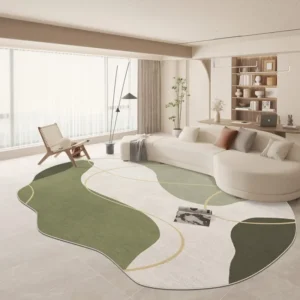 Large Area Green Rugs for Bedroom Nordic Living Room Decoration Shaped Carpet Irregular Plush Lounge Rug Home Thick Washable Mat
Rated 5.00 out of 5$54.94 – $346.41Price range: $54.94 through $346.41
Large Area Green Rugs for Bedroom Nordic Living Room Decoration Shaped Carpet Irregular Plush Lounge Rug Home Thick Washable Mat
Rated 5.00 out of 5$54.94 – $346.41Price range: $54.94 through $346.41 -
 Nordic Style Rugs for Bedroom Morandi Living Room Decoration Carpet Large Area Geometry Lounge Rug Home Cloakroom Non-slip Mat
Rated 5.00 out of 5$39.46 – $597.66Price range: $39.46 through $597.66
Nordic Style Rugs for Bedroom Morandi Living Room Decoration Carpet Large Area Geometry Lounge Rug Home Cloakroom Non-slip Mat
Rated 5.00 out of 5$39.46 – $597.66Price range: $39.46 through $597.66 -
 Irregular Shapes Living Room Decoration Carpet Modern Style Rugs for Bedroom Home Thicken Plush Rug Fluffy Soft Lounge Floor Mat
Rated 4.83 out of 5$55.91 – $347.82Price range: $55.91 through $347.82
Irregular Shapes Living Room Decoration Carpet Modern Style Rugs for Bedroom Home Thicken Plush Rug Fluffy Soft Lounge Floor Mat
Rated 4.83 out of 5$55.91 – $347.82Price range: $55.91 through $347.82

